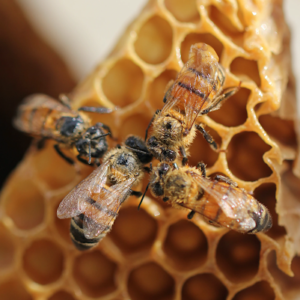
Research done by entomology professor Adam Dolezal, computer scientist Tim Gernat of the University of Illinois, and other scholars across universities, in monitoring the behavior of honeybees, has revealed that behavior in bee colonies has the ability to suppress the spread of infectious diseases. However, unusual conditions with the Israeli Acute Paralysis Virus (IAPV) has proved more difficult for their social immunity system to prevent from spreading the disease. This is an imminent issue as it has the power to drastically decline the populations of honeybees, which we rely on for their pollination.
The research team was able to track about 900 individual bees behaviors to see how bees infected with IAPV, bees with an immune response activated, and healthy bees interact in multiple colonies. In the colonies that the bees belonged to, they were less likely to engage in sharing food, through a process known as trophallaxis, with sick bees even though the infected bees were moving around the hive to find some food. It seems hives have built in mechanisms to prevent spread of disease but these mechanisms fail when it is bees from other hives.
The honeybees infected with the virus were more easily able to gain entrance to other colonies’ hives from the “guard bees” compared to past infectious diseases, which means that IAPV evolved to disguise itself in bees’ bodies against the chemical signals discoverable via antennae. In some cases even increasing their odds more than that of a non-infected foreign bee.
The information from studying how the virus is able to remain hidden in honeybees and spread so far and quickly is compelling for its contribution to commercial beekeeping for pollination. Beehives in commercial beekeeping operations are often much closer to each other than they would be in the wild. Bees who are infected with IAPV often become disoriented and can return to the wrong hive. With this study showing guard bees are more likely to let in bees affected by IAPV than other diseases, it shows how this disease has adapted for spread farther and can be devastating to hives that are in close proximity to each other.
- Morrill Hall – Home of the Dolezal Bee Research Lab, where part of the research took place.
Amiri, E., Seddon, G., Smith, W. Z., Strand, M. K., Tarpy, D. R., Rueppell, O. (2019). Israeli Acute Paralysis Virus: Honey Bee Queen–Worker Interaction and Potential Virus Transmission Pathways. Insects 10(1), 9. doi: 10.3390/insects10010009
Cohron, S. (2020) Brown and black wasp on yellow surface. Unsplash. https://unsplash.com/photos/brown-and-black-wasp-on-yellow-surface-UQwbKtu-2Ek
Geffre, A. C., Gernat, T., Harwood, G. P., Jones, B. M., Gysi, D. M., Hamilton, A. R., Bonning, B. C., Toth, A. L., Robinsone, G. E., & Dolezal, A. G. (2020). Honey bee virus causes context-dependent changes in host social behavior. Proceedings of the National Academy of Sciences (19), 10406-10413. https://doi.org/10.1073/pnas.2002268117
Iowa State University. (2020, Apr 27). Researchers Find Bee Virus Spreads by Altering Honey Bees’ Social Distancing Behavior. College of Agriculture and Life Sciences. https://www.cals.iastate.edu/news/2020/researchers-find-bee-virus-spreads-altering-honey-bees-social-distancing-behavior
Stokstad, E. (2020, Apr. 28). Deadly virus turns honey bees into Trojan horses. Science. https://www.science.org/content/article/deadly-virus-turns-honey-bees-trojan-horses
Yates, D. (2020, Apr 27). Virus-infected honey bees more likely to gain entrance to healthy hives. University of Illinois News Bureau. https://news.illinois.edu/view/6367/808197
